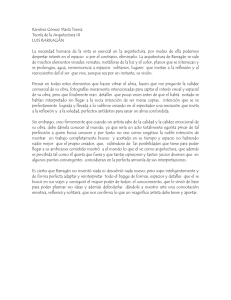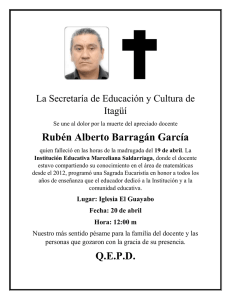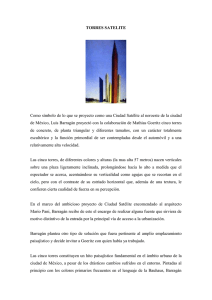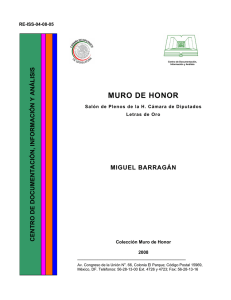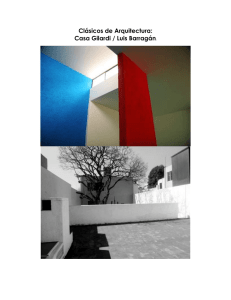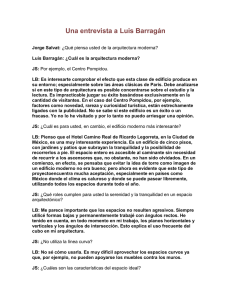KAHN Y BARRAGÁN. Convergencias en la plaza del Instituto Salk
Anuncio
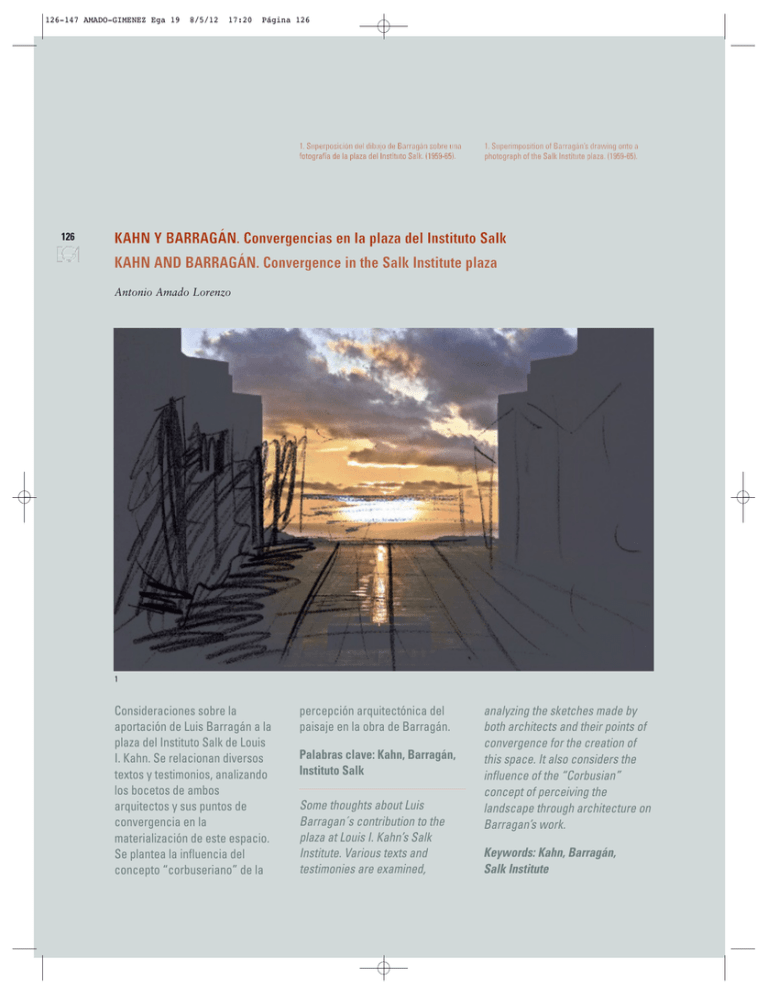
126-147 AMADO-GIMENEZ Ega 19 8/5/12 17:20 Página 126 1. Superposición del dibujo de Barragán sobre una fotografía de la plaza del Instituto Salk. (1959-65). 126 1. Superimposition of Barragán’s drawing onto a photograph of the Salk Institute plaza. (1959-65). KAHN Y BARRAGÁN. Convergencias en la plaza del Instituto Salk KAHN AND BARRAGÁN. Convergence in the Salk Institute plaza Antonio Amado Lorenzo 1 Consideraciones sobre la aportación de Luis Barragán a la plaza del Instituto Salk de Louis I. Kahn. Se relacionan diversos textos y testimonios, analizando los bocetos de ambos arquitectos y sus puntos de convergencia en la materialización de este espacio. Se plantea la influencia del concepto “corbuseriano” de la percepción arquitectónica del paisaje en la obra de Barragán. Palabras clave: Kahn, Barragán, Instituto Salk Some thoughts about Luis Barragan´s contribution to the plaza at Louis I. Kahn’s Salk Institute. Various texts and testimonies are examined, analyzing the sketches made by both architects and their points of convergence for the creation of this space. It also considers the influence of the “Corbusian” concept of perceiving the landscape through architecture on Barragan’s work. Keywords: Kahn, Barragán, Salk Institute 126-147 AMADO-GIMENEZ Ega 19 8/5/12 17:20 Página 127 expresión gráfica arquitectónica 2. Luis Barragán en los años ochenta. 2. Luis Barragán in the 1980s. Introducción Introduction En el conjunto de la obra construida de Louis Isadore Kahn (1901-74), el Jonas Salk Institute for Biological Studies de La Jolla, California (1959-65), destaca como una de sus obras más representativas. En su plaza abierta, el pavimento de mármol travertino apenas se distingue cromáticamente de los edificios de hormigón armado visto que la delimitan y que enmarcan una sugestiva vista hacia el horizonte del Océano (fig.1). Sin embargo, esta plaza habría sido muy diferente si se hubiese llevado a cabo según las intenciones iniciales de Kahn. Así, la aportación puntual de otro importante arquitecto de su generación, Luis Barragán Morfín (19021988), fue decisiva. Tal y como se puede observar en uno de los bocetos preliminares datado en 1962 (fig. 3), e incluso en otro anterior a diciembre de 1965 (fig. 4), Kahn había imaginado un espacio ajardinado a modo de oasis relajante, una zona de descanso al aire libre para esparcimiento o reuniones informales de los investigadores. Buscaba sin duda un espacio con vegetación exuberante, en contraste con la imagen dura y fría de las fachadas de los bloques de laboratorios. El arquitecto llegó a experimentar directamente sobre el terreno, buscando las especies vegetales más adecuadas, pero a medida que avanzaba el resto de la obra, seguía sin estar totalmente convencido de la solución definitiva. Un tercer boceto, también de 1962, avanzaba el remate final y escalonado de una plaza arbolada con varias filas de álamos (fig. 5). If we consider all of Louis Isadore Kahn’s (1901-74) built works, the Jonas Salk Institute for Biological Studies in La Jolla, California (1959-65), stands out as one of his most representative. In its open plaza, the travertine marble flooring can scarcely be chromatically distinguished from the reinforced concrete buildings surrounding it and framing a fascinating view of the Ocean horizon (fig. 1). However, this plaza would have been very different if it had been created on the basis of Kahn’s original intentions. So the contribution from another important architect of his generation, Luis Barragán Morfin (1902-1988), was decisive. As can be seen from one of the preliminary sketches dating from 1962 (fig. 3), and even in another prior to December 1965 (fig. 4), Kahn had imagined a garden space in the style of a relaxing oasis, an open air rest area where researchers could enjoy their free time or hold informal meetings. He clearly sought a space with lush vegetation, in contrast to the cold, hard image of the laboratory block façades. The architect experimented directly on the soil, seeking the most suitable plant species, but as the rest of the work advanced he was still not fully convinced of the final solution. A third sketch, also from 1962, advanced the final and staggered plan for a tree-lined plaza with several rows of poplars (fig.5). Barragán, paisajista Louis I. Kahn valoraba los trabajos de paisajismo de Luis Barragán que cono- 2 cía a través de publicaciones como Modern Gardens in the Landscape (Kassler, 1964), en la que precisamente una obra suya aparecía en la portada 1. De hecho –y aparte de Le Corbusier–, Barragán era el único arquitecto contemporáneo a quien Kahn citaba habitualmente en sus conferencias (Ingersoll 2001, 220). El 19 de enero de 1965 –antes de viajar a Pakistán por un mes–, Kahn telefoneó a Barragán para solicitar su colaboración para el “jardín”, escribiendo después una carta personal en la que elogiaba sus obras publicadas (Treib 2006, 404): Estoy muy impresionado con su trabajo en el Museo de Arte Moderno, el folleto de Arquitectura del Paisaje, y siento que su orientación será de importancia para el desarrollo del terreno interior del Instituto Salk. Debido al limitado conocimiento del idioma inglés por parte de Barragán, éste no reconoció a su interlocutor telefónico hasta semanas más tarde, cuando recibió la carta de Kahn, acompañada de un libro monográfico sobre su arquitectura. Fue entonces cuando comprendió quién era realmente el misterioso ame- Barragán, landscape architect Louis I. Kahn had great regard for the landscape architecture works of Luis Barragán which he had discovered through publications such as Modern Gardens in the Landscape (Kassler, 1964), in one edition of which his works appeared on the front cover 1. In fact, apart from Le Corbusier, Barragán was the only contemporary architect regularly cited by Kahn in his conferences (Ingersoll 2001, 220). On 19th January 1965, before travelling to Pakistan for a month, Kahn called Barragán to ask for his help with the “garden”, later writing a personal letter in which he praised his published works (Trieb 2006, 405): I was very much impressed with your work in the Museum of Modern Art booklet on Landscape Architecture, and feel that your guidance will be of importance for the land development of the canyon site of the Salk Institute. 127 126-147 AMADO-GIMENEZ Ega 19 8/5/12 17:20 Página 128 128 3 4 Due to Barragan’s limited knowledge of English, he had no idea of the identity of the caller until weeks later when he received Kahn’s letter, accompanied by a monograph on his architecture. It was then that he finally realized who this mysterious American was; an architect whose work he knew only too well (Trieb 2006, 405): I know your work since years by reproductions and to (sic) admire it sincerely … In other words: I do consider any collaboration with you as a great honor. Given the geographical proximity of the two countries, Barragan was used to regular and direct contact with the United States from the thirties onwards. In 1951 he had given a lecture there about his landscape architecture works: Gardens for Environment: Jardines del Pedregal (Trieb 2006, 404). In fact, his expertise as a landscape architect had largely been self-taught, experimenting on his own land, where he had also acted as property developer (Eggen 2001, 146): During those years I spent time creating some gardens on my property and it really entertained me, I had fun and that is what opened up a name to me, with a qualification designated in the U.S.A as Landscape Architect. Kahn in Mexico In December 1965 Khan visited Mexico City where he was impressed by the austere language of Barragán’s constructions (fig. 7), and specifically by works such as the architect’s own house or the Jardines del Pedregal. Khan’s enthusiasm was evident (Rodríguez Salinas 1996, 33): ricano, un arquitecto cuya obra conocía perfectamente (Treib 2006, 405): Conozco su trabajo desde hace años a través de publicaciones y lo admiro sinceramente… En otras palabras: considero cualquier colaboración con Ud. como un gran honor. Dada la proximidad geográfica de ambos paises, los contactos directos con Estados Unidos eran bastante habituales para Barragán desde los años treinta. En 1951 había impartido una conferencia allí sobre sus obras de paisajismo: Gardens for Environment: Jardines del Pedregal (Treib 2006, 404). En realidad, su especialización como paisajista había sido básicamente autodidacta, experimentando en terrenos de su propiedad en los que también había actuado como promotor inmobiliario (Eggener 2001, 146): Durante esos años me ocupé de realizar algunos jardines de mi propiedad que me entretuvieron mucho, me divirtieron y fue lo que me abrió un nombre, con título que hay o como se designa (sic) en EEUU de Arquitecto Paisajista. Kahn en México En diciembre de 1965, Kahn visitó México D.F., donde quedó impresionado por el lenguaje austero de las construc- ciones de Barragán (fig. 7), y en concreto por obras como la propia casa del arquitecto o los jardines de El Pedregal. El entusiasmo de Kahn era evidente (Rodríguez Salinas 1996, 33): Conocí a un arquitecto en México: Luis Barragán. ... Descubrí que es un hombre absolutamente notable ... Sus jardines no tienen más que un pequeño vertedero de agua y son, sin embargo, tan inmensos que todos los arreglos paisajísticos del mundo no podrían igualarlos. Kahn le pidió a Barragán que viajase a California (8/feb/1966) para conocer in situ lo que estaba construyendo y sobre todo para que le asesorase, una vez que la obra estaba ya muy avanzada y sus líneas principales claramente definidas. La aportación de Barragán a la obra del Instituto Salk no fue simplemente verbal sino que se materializó en una perspectiva central dibujada a mano alzada, que representa una propuesta minimalista (fig. 9). En ella no aparecen figuras humanas, al contrario que en los bocetos precedentes de Kahn. Un dibujo que no tiene fecha, aunque todo parece indicar que se realizó posteriormente a su visita 2. La comparación entre la perspectiva de Barragán y la de Kahn indica dos planteamientos diferentes para un mismo espacio, pero si esta última (fig. 4) 126-147 AMADO-GIMENEZ Ega 19 8/5/12 17:20 Página 129 expresión gráfica arquitectónica 129 5 6 se compara a su vez con un proyecto del mexicano de varios años antes (fig. 8), puede resultar más comprensible la colaboración buscada por Kahn. Esta colaboración no dejaba de ser totalmente profesional. De hecho, los honorarios profesionales de Barragán fueron abonados por el norteamericano como si se tratase de cualquier otra asesoría especializada (Ingersoll 2001, 220) 3. El boceto a lápiz de Barragán, adelanta con claridad la solución que sería adoptada definitivamente, aportando un leve toque de color, apenas unas líneas azules para representar el Océano Pacifico Norte, cuya línea de costa dista unos 700 metros del edificio Salk. Barragán en California Las poéticas palabras de Kahn recordando la visita (24/feb/1966), de Barragán a La Jolla, no dejan lugar a dudas sobre la impresión recibida por Kahn (Brownlee y De Long 1991, 144): Cuando (Barragán) entró en aquel espacio, se dirigió a los muros de hormigón, los tocó y expresó su amor por ellos (sic). Al mismo tiempo que su mirada atravesaba el espacio hacia el mar dijo: Yo no pondría un árbol ni una sola brizna de hierba en este espacio. Esto debería ser una plaza de piedra, no un jardín. 3. Louis I. Kahn (1962). Boceto preliminar de la plaza (carboncillo, 35,3 x 76,2 cm). 4. Louis I. Kahn (1965). Dibujo preliminar de la plaza (lápiz, 55,8 x 44,8 cm). 5. Louis I. Kahn (1962). Boceto preliminar de la plaza. Fachada hacia el Océano (carboncillo, 35,3 x 72,5 cm). 6. Louis I. Kahn en los años setenta. ... Miré al Dr. Salk y él a mí, y ambos sentimos que era totalmente correcto. Notando nuestra aprobación, (Barragán) añadió encantado: “Si Ud. construye esta plaza, ganará una fachada, una fachada hacia el cielo”. La solución presentada a Jonas Salk, inventor de la vacuna contra la poliomielitis y promotor del centro de investigación, como una “plaza para todas las naciones” –según palabras de Luis Barragán–, fue finalmente aceptada, no sin ciertas reticencias, puesto que le estaban proponiendo un espacio público y no uno privado, como había planteado inicialmente Jonas Salk (Steele 1993, 5). Serenidad y silencio Es preciso recordar aquí que el reconocimiento de las obras de Kahn fue relativamente tardío y que sus obras de madurez proponían una abstracción volumétrica que enlazaba con la 3. Louis I. Kahn (1962). Preliminary sketch of the plaza, (charcoal, 35.3 x 76.2 cm). 4. Louis I. Kahn (1965). Preliminary drawing of the plaza, (pencil, 55.8 x 44.8 cm). 5. Louis I. Kahn (1962). Preliminary sketch of the plaza. Façade towards the Ocean. (charcoal, 37.5 x 72.5 cm). 6. Louis I. Kahn in the 1970s. I met an architect in Mexico: Luis Barragán. ... I discovered that he is a truly noteworthy man.... His gardens have nothing more than a small water outlet and yet are so immense that all of the landscape arrangements in the world could not match them. Kahn asked Barragán to go to California (8th Feburary 1966) once the work was very advanced and its main lines clearly defined, so that he could see in person what he was constructing and above all advise him. Barragán’s contribution to the Salk Institute work was not simply verbal, but instead involved a central perspective drawn freehand, which represented a minimalist proposal (fig. 9). It contains no human figures, which contrasts with the preceding sketches created by Kahn. It is an undated sketch, although everything seems to point to it being drawn after his visit 2. Comparing the perspectives by Barragán and Kahn we can see two different ways of thinking about the same space, but if the second of these (fig. 4) is in turn compared with a project by the Mexican dated several years earlier (fig. 8), it is easier to understand the collaboration sought by Kahn. The collaboration was kept on a completely professional footing. In fact, Barragán’s fees were paid by the North American just as he 126-147 AMADO-GIMENEZ Ega 19 8/5/12 17:20 Página 130 7. Luis Barragán. Fuente en Las Arboledas, (1958-61). 8. Luis Barragán. Patio y fachada del Templo del Calvario en los Jardines del Bosque, (1955-61). 9. Luis Barragán. Propuesta para la plaza del Instituto Salk, (1966). 130 would pay for any other specialist advice (Ingersoll 2001, 220) 3. The pencil sketch by Barragán clearly anticipates the solution that would finally be adopted, adding a slight touch of colour with just a few blue lines to represent the North Pacific Ocean whose coastline is approximately 700 metres from the Salk building. En los jardines y las casas diseñadas por mí, siempre he procurado permitir el plácido murmullo del silencio, y en mis fuentes, el silencio canta. ... Tenemos la necesidad y la obligación de crear ambientes serenos. Debemos procurar que esta sensación se contagie y comunique. Barragán in California The poetic words of Khan when recalling Barragán’s visit (24th February 1966) to La Jolla leave no room for doubt about the impression he made on Kahn (Brownlee and De Long 1991, 144): When he [Barragán] entered the space he went to the concrete walls and touched them and expressed his love for them, and then he said as he looked across the space and towards the sea. “I would not put a tree or blade of grass in this space. This should be a plaza of stone, not a garden.” I [Kahn] looked at Dr. Salk and he at me and we both felt this was deeply right. Feeling our approval, he added joyously, “If you make this a plaza, you will gain a façade–a façade to the sky.” The solution presented to Jonas Salk, inventor of the polio vaccine and the man developing the research centre, for, in the words of Luis Barragán, a “plaza for every nation”, was finally accepted, although not without a certain reticence given that the proposal put to him was for a public rather than a private space, as he had initially specified (Steele 1993, 5). Serenity and silence It is important to remember at this point that recognition of Kahn’s work came relatively late and that his mature works proposed a volumetric abstraction that was linked to the monumental nature of large ancient buildings. In relation to Luis Barragán, in the 1970s he was better known internationally for a more personal style of architecture, based on traditional Mexican construction and its intense colours, and much less for his town planning or landscape architecture works. Louis I. Kahn was not expecting, and nor did he need, advice or suggestions from the Mexican architect about the architectural aspects of his work at La Jolla. Instead what he sought was the “green” contribution from a specialist in landscape architecture. 7 monumentalidad de las grandes construcciones de la Antigüedad. En lo que respecta a Luis Barragán, en los años sesenta del siglo XX era más conocido a nivel internacional por una arquitectura muy personal, apoyada en la construcción tradicional mexicana y sus intensos colores, pero mucho menos por sus realizaciones urbanísticas o paisajísticas. Louis I. Kahn no esperaría –ni necesitaría– consejos o sugerencias del arquitecto mexicano sobre planteamientos arquitectónicos para su obra de La Jolla, sino que buscaba la aportación “verde” de un especialista en arquitectura paisajística. A pesar de todo, la sencillez y serenidad de la propuesta de Barragán, con la vegetación limitada a los extremos de la plaza (fig. 10c), es paradójicamente más cercana a la que podríamos esperar inicialmente de Kahn, es decir, una plaza “dura”, abstracta y simbólica. Es oportuno considerar al respecto las significativas palabras pronunciadas por Luis Barragán en su discurso de aceptación del Premio Pritzker en 1980: El minimalista canal de agua de más de 60 m. de la plaza (fig. 10b), que ya aparecía en bocetos preliminares de Kahn, se estiliza al máximo para convertirse en una larga línea que parece verter aguas en el océano distante. En palabras de Barragán (Brownlee y De Long 1991, 441): ... Una plaza unirá los dos edificios, y al final, Ud. verá la línea del mar. Robert Venturi califica este clásico y potente eje de simetría, abierto en sus dos extremos hacia este y oeste, hacia tierra y mar, como un “gesto significativo dentro de un paisaje americano”, una imagen simbólica “que enmarca el mar y la tierra, donde termina el viejo oeste y empieza la nueva frontera oriental” (Venturi y Scott Brown 1996, 25). Un juego elemental de agua que remite evidentemente a los jardines mediterráneos de la Alhambra de Granada, visitados por Luis Barragán en 1924, que tanto influyeron en su concepción de los espacios ajardinados. La influencia de G. de Chirico Tampoco se puede pasar por alto la influencia de la pintura surrealista o metafísica de Giorgio de Chirico (18881978) en la arquitectura de Barragán y en concreto de los espacios urbanos vacíos, desolados y profundamente melancólicos que se repiten una y otra vez en sus cuadros (Eggener 2001, 80) 4. El profundo interés del arquitecto por la obra pictórica de Chirico también es evidente, a juzgar por los vo- 126-147 AMADO-GIMENEZ Ega 19 8/5/12 17:20 Página 131 expresión gráfica arquitectónica 7. Luis Barragán, Fountain in Las Arboledas, (1958-61). 8. Luis Barrragán. Patio and facade of the Calvario Temple in Jardines del Bosque. (1955-61). 9. Luis Barragán. Proposal for the plaza at the Salk Institute, (1966). lúmenes existentes en la biblioteca personal de Barragán (Riggen 1996, 104). Las elocuentes palabras del arquitecto, correspondientes a una entrevista realizada en 1976 por la escritora Elena Poniatowska, no dejan lugar a dudas (Eggener 2001, 151): ¿Sabes, Elenita, quién me ha influenciado mucho?, El Chirico. La magia que siempre busqué la encontré en él. Cuando vi sus cuadros, pensé: “Esto es lo que yo puedo llegar a realizar también en la arquitectura de paisajes”. Comparar Piazza d´Italia, el conocido óleo de Giorgio de Chirico del año 1913 (fig. 11), una vista obsesiva sobre la que insistió durante años en cuadros muy similares, con el boceto de Barragán para el Instituto Salk (fig. 9), o mejor aún, con una fotografía de su plaza orientada a poniente, al atardecer (fig. 12), puntualiza las referencias en un espacio vacío y definido por dos construcciones moduladas, simétricas y paralelas que enmarcan el paisaje (fig. 10a-d-e). Un pequeño volumen en forma de paralelepípedo pétreo aparece en primer plano, tanto en la plaza como en el cuadro. La luz del atardecer, representada en el óleo con unas degradadas bandas horizontales, equivale aquí a las tonalidades doradas del horizonte marino. El paisaje enmarcado La propuesta de Barragán está además en la línea conceptual de “paisaje enmarcado” planteada por Le Corbusier durante años. El mexicano lo había conocido –aunque fugazmente– en París, en 1931, asistido a sus conferencias y visitado sus primeras obras en Francia 5. La influencia “corbuseriana” en Barragán no se limitaría a su etapa racio- 131 8 9 nalista, como frecuentemente se cita, sino que es perceptible en las fotografias de sus obras y –para lo que interesa aquí–, en el concepto escenográfico de la percepción del paisaje desde la arquitectura. Posteriormente a su viaje a Brasil de 1936, Le Corbusier había dejado constancia de este concepto en sus escritos, refiriéndose a las perspectivas de la ciudad de Río de Janeiro (Boesiger 1946, 80-81) (fig. 13, 14 y 15): Despite everything, the simplicity and serenity of Barragán’s proposal, with the vegetation limited to the two ends of the plaza (fig. 10c), is paradoxically closer to what we could initially have expected from Kahn. In other words a “hard”, abstract and symbolic plaza. It is helpful at this point to consider the words of Luis Barragán in his acceptance speech for the Pritzker Award in 1980: In the gardens and homes designed by me, I have always endeavoured to allow for the interior placid murmur of silence, and in my fountains, silence sings ... We have the need and the obligation to create serene environments. We must ensure that this sensation is passed on and communicated. 126-147 AMADO-GIMENEZ Ega 19 8/5/12 17:20 Página 132 10. Análisis gráfico de la plaza. (D. del autor). a. Modulación. b. Agua. c. Zonas verdes. d. Entorno. e. Espacio de la plaza. 132 The minimalist water channel in the plaza measuring more than 60m long (fig. 10b), which had already appeared in Kahn’s preliminary sketches, is stylised to the maximum to turn it into a long line that seems to pour water into the distant ocean. In the words of Barragán (Brownlee and De Long 1991, 334): 10. Graphic analysis of the plaza. (Author’s drawings). a. Modulation, b. Water. c. Green areas. d. Surroundings e. Space for the plaza. 10a Los comentarios de Barragán, entresacados de una conferencia de 1951, sintonizan por completo con Le Corbusier (Eggener 2001, 76) 6: … A plaza will unite the two buildings and at the end, you will see the line of the sea. Robert Venturi called this classic and powerful axis of symmetry, open at its two ends to the east and west, toward the land and the sea, an “important gesture within an American landscape”, a symbolic image “that frames the sea and the land, where the old west finishes and the new eastern frontier begins” (Venturi and Scott Brown 1996, 25). It is an elemental water game clearly reminiscent of the Mediterranean gardens of the Alhambra in Granada, visited by Luis Barragán in 1924, which had so much influence over his creations for garden areas. 10b The influence of G. de Chirico Nor should one overlook the influence of the surrealist or metaphysical paintings of Giorgio de Chirico (1888-1978) on Barragán’s architecture, and specifically the empty, desolate and deeply melancholic urban spaces that are seen again and again in his paintings (Eggener 2001, 80) 4. The great interest held by Barragán in the pictorial works of de Chirico is also evident from the books to be found in the architect’s personal library (Riggen 1996, 104). The eloquent words of the architect during an interview with the writer Elena Poniatowska in 1976 leave no room for doubt (Eggener 2001, 151): Do you know, Elenita, who has influenced me a great deal? De Chirico. I found in him the magic that I always searched for. When I saw his paintings, I thought: This is what I can do with landscape architecture.” El pacto con la naturaleza se selló. ¡Un marco alrededor!. ¡Las cuatro (líneas) oblicuas de una perspectiva!. La sala se encuentra frente al sitio. Todo el paisaje entra en la habitación. 10c No se debe exagerar el tema de las vistas panorámicas ... porque un paisaje que se capta y enmarca con un primer plano adecuado tiene un valor doble. Un paisaje que se realza por tanto, por el marco perimetral de la propia arquitectura. La interpretación es similar en el Instituto Salk, con vistas enmarcadas del Océano Pacífico, aunque esta vez sin un marco superior, abriéndose a cielo y nubes del paisaje californiano. En este sentido, una fotografía como la del interior de la sala de estar del apartamento de los Jardines del Pedregal (fig. 16), en la que se percibe el paisaje de manera similar a la de los bocetos de Le Corbusier, no puede considerarse en absoluto casual, teniendo en cuenta que Luis Barragán era sumamente cuidadoso en la elección de acreditados fotógrafos como su compatriota Armando Salas (autor de la fotografía), y que controlaba cuidadosamente las imágenes que se publicaban sobre sus obras. 10d Barragán Foundation Comparing Piazza d´Italia, the well known oil painting by Giorgio de Chirico from 1913 (fig. 11), an obsessive image that would be repeated for years in very similar paintings, with Barragán’s sketch for the Salk Institute (fig. 9), or better still, with a photograph of its plaza itself facing the west, at dusk (fig. 12), shows the references in an empty space, one defined by two modulated, symmetrical and parallel constructions that frame the landscape (fig. 10a-d-e). La Barragán Foundation, que alberga la documentación: planos, dibujos, etc., del arquitecto, no tiene su sede en México, sino en Suiza, concretamente en Birsfelden, ciudad del cantón de Basilea, después de que sus fondos fuesen finalmente adquiridos –en 1996– por la firma Vitra a la galería Max Protech de Nueva York 7. El gobierno de 10e 126-147 AMADO-GIMENEZ Ega 19 8/5/12 17:20 Página 133 expresión gráfica arquitectónica 11. Giorgio de Chirico, Piazza d’Italia (1913). 12. La plaza del Instituto Salk al atardecer. 11. Giorgio de Chirico, Piazza d´Italia (1913). 12. The Salk Institute plaza at dusk. 133 11 12 México no pareció aportar en su momento el suficiente interés en conservar la colección para su país. Una consulta reciente a esta institución suiza, confirmó que no consta en sus archivos la existencia de otros dibujos de Barragán sobre el Instituto Salk diferentes al que se reproduce en estas páginas, y que no se trata de un pequeño boceto de una libreta, sino de un dibujo con un tamaño cercano a un DIN A3 8. rio por tanto un punto de vista ajeno para reafirmar su concepción monumental de la arquitectura y superar sus dudas iniciales. Desde su inauguración, este centro de investigación se considera una obra de madurez de Kahn. La mayoría de las publicaciones inciden una y otra vez en las imágenes impactantes de la plaza, un espacio abierto convertido no sólo en icono representativo del Instituto Salk sino también de toda la arquitectura de Louis I. Kahn. Las palabras de Barragán recogidas en una emotiva carta enviada el 6 de abril de 1966, son significativas sobre su admiración por la obra californiana de Louis I. Kahn: Conclusiones Louis I. Kahn, arquitecto de volúmenes primarios materializados en potentes conjuntos abstractos (fig. 17), acudió a Barragán para añadir algo más que un jardín, buscando un factor humano que consideraría ausente en una obra que se aproximaba a su finalización. La propuesta del arquitecto mexicano, influida por Le Corbusier y por los espacios urbanos desolados de la pintura surrealista de Giorgio de Chirico era, en cierto modo, más “kahniana” que lo que habría esperado el propio Kahn (quien por cierto, la aceptó inmediatamente). Fue necesa- Estoy muy contento por haber tenido la oportunidad de visitar una de sus obras maestras, el Instituto Salk. Este conjunto me dejó profundamente impresionado y visitándolo, me sentí conmovido de una manera que rara vez ocurre en nuestra propia vida. NOTAS 1 / La obra reproducida es una fuente-bebedero para caballos en Las Arboledas, en las afueras de México DF (1959). 2 / Como respuesta a una consulta reciente del autor del artículo, la Barragán Foundation señaló esta circunstancia como la más probable. A small volume in the form of a stone parallelepiped appears in the foreground in both the plaza and the painting. The light at dusk, represented in the oil painting by some faded horizontal bands, is equivalent here to the golden tones of the sea horizon. The framed landscape Barragán’s proposal is also in keeping with an idea developed by Le Corbusier over several years; that of a “framed landscape”. The Mexican had met Le Corbusier, albeit fleetingly, in Paris in 1931, attended his conferences and visited his main works in France 5. The “Corbusian” influence on Barragán was not limited to his rationalist stage, as is frequently argued, but rather can be seen in the photographs of his works, and, in terms of what interests us here, in the scenographic idea of perceiving the landscape through architecture. After his trip to Brazil in 1936, Le Corbusier discussed this concept in his writings, referring to the perspectives of the city of Rio de Janeiro (Boesiger 1946, 80-81) (fig. 13, 14 and 15): The pact with nature was sealed. A surrounding frame! The four obliques (lines) of a perspective! The room is found opposite the site. The entire landscape enters the room. Barragán’s comments, taken from a conference in 1951, are completely in tune with Le Corbusier (Eggener 2001, 76) 6: One must not overdo the theme of circular panoramic vistas … because a landscape that is held and framed with a proper foreground is worth double. 126-147 AMADO-GIMENEZ Ega 19 134 8/5/12 17:20 Página 134 A landscape is therefore created by the perimeter frame of the architecture itself. The interpretation is similar in the Salk Institute, with framed views of the Pacific Ocean, although this time without the upper frame, opening up to the sky and the clouds of the Californian landscape. Given this, a photograph such as the one of the inside of the lounge in the apartment at the Gardens of El Pedregal (fig. 16), in which the landscape can be perceived in a way that is similar to Le Corbusier’s sketches, cannot be considered to be a complete coincidence, given that Luis Barragán was extremely careful to choose the photographs with his compatriot Armando Salas (who took the photographs), and carefully controlled the images of his published works. 13 14 The Barragán Foundation The Barragán Foundation, which houses the architect’s documentation (plans, drawings, etc.), does not have its offices in Mexico. Instead they are in Switzerland, in Birsfelden, a city in the Basel canton. This collection was finally acquired in 1996 by the Vitra Company from the Max Protech Gallery in New York 7. At the time in question it appears that the Mexican Government did not show enough interest to keep the collection in their country. A recent enquiry to this Swiss institution has confirmed that their archives do not contain any drawings by Barragán of the Salk Institute that are not shown in this article. It has also confirmed that instead of being a small sketch in a notebook the drawing was in fact almost the size of an A3 sheet 8. Conclusions Louis I. Kahn, an architect of primary volumes creating powerful abstract works (fig. 17), looked to Barragán to add something more than a garden, seeking the human factor that he considered to be lacking in a work that was close to completion. The proposal by the Mexican architect, influenced by Le Corbusier and by the desolate urban spaces seen in the surrealist paintings of Giorgio de Chirico, was to a certain degree more “Kahnian” than Kahn himself had been expecting (he immediately accepted it). It seems therefore that he required an independent view to reaffirm his ideas about monumental architecture and overcome his initial concerns. Since its inauguration, this research centre has been considered a mature work by Kahn. Most 15 3 / De hecho, el estudio de Kahn transfirió 1.000 dólares al de Barragán en concepto de honorarios por su colaboración. 4 / Eggener profundiza en su libro sobre la relación entre la pintura de Giorgio de Chirico y las instantáneas de Armando Salas Portugal (fotógrafo habitual de la obra de Barragán), imágenes totalmente controladas por el arquitecto. 5 / Entre otras obras, Barragán había visitado en 1924-1925 el Pabellón de L´Esprit Nouveau, en la Exposición Internacional de Artes Decorativas de París. 6 / Extracto de la conferencia citada sobre los Jardines del Pedregal en 1951. 7 / A la muerte de Luis Barragán, en 1988, su archivo pasó a manos de Rosario Uranga, viuda de Raúl Ferrera, socio de Barragán. La firma Vitra pagó en 1996 unos 2,5 millones de dólares por los fondos. 8 / El uso de estas libretas de apuntes tipo Moleskine era habitual tanto en Le Corbusier, Kahn como en Barragán. “Sólo hay este sencillo boceto; su tamaño es aproximadamente un A3”. “De hecho es el único dibujo realizado por la mano de Barragán y conocido hasta el momento”. (Respuestas de Martin Josephy de la Barragán Foundation al autor 5/8/2010 y 27/9/2011). Referencias – BOESIGER, Willy, 1946. Le Corbusier - Oeuvre Complète, vol. IV: 1938-46. Zurich: Les Editions d´Architecture. – BROWNLEE, David y DE LONG, David, 1991. Kahn: In the Realm of Architecture. New York: Rizzoli. – EGGENER, Keith L., 2001. Luis Barragán´s Gardens of El Pedregal. New York: Princeton Architectural Press. – INGERSOLL, Richard, 2001. In the shadows of Barragán. Luis Barragán: The quite revolution. Milan: Skira. – KASSLER, Elizabeth, 1964. Modern Gardens in the Landscape. New York: MOMA. – RODRÍGUEZ SALINAS, Salvador, 1996. Barragán. Obra Completa. Sevilla: Tanais Ediciones. – STEELE, James, 1993. Salk Institute. London: Phaidom. – TREIB, Marc, 2006. To End a Continent. The Courtyard of the Salk Institute. Journal of the Society of Architectural Historians, vol. 65, nº 3. – RIGGEN MARTÍNEZ, Antonio, 1996. Luis Barragán 19021988. Milán: Electa. – VENTURI, Robert y SCOTT BROWN, Denise, 1996. A Protest Concerning the Extension of the Salk Center.Robert Venturi’s Iconography and Electronics Upon a Generic Architecture: A View from the Drafting Room. Cambridge: MIT Press. – VV. AA., 1987. Louis I. Kahn, vol. 2. Buildings and Projects, 1959-61. New York & London: Garland. Referencias de imágenes 1-10-12 / Archivos de la Barragán Foundation. Birsfelden, Suiza. Panorámica de la plaza: “One man down” blog. (Superposición del autor). 2 / Página web oficial “The Pritzker Architecture Prize”. 3-4 / 9-5 / (pp. 86-49-87). VV. AA., 1987. Louis I. Kahn, vol. 2. Buildings and Projects, 1959-61. New York & London: Garland. 6 / (p. 25). Brownlee, David y De Long, David, 1991. Kahn: In the Realm of Architecture. New York: Rizzoli. 7 / (p. 126). Eggener, Keith L., 2001. Luis Barragán´s Gardens of El Pedregal. New York: Princeton Architectural Press. 8 / (p. 173). Riggen Martínez, Antonio, 1996. Luis Barragán 1902-1988. Milán: Electa. 13 / “One man down” blog. 14-15-16 / (p. 80). Boesiger, Willy, 1946. Le Corbusier - Oeuvre Complète, vol. IV: 1938-46. Zurich: Les Editions d´Architecture. 17 / (p. 55). Eggener, Keith L., 2001. Luis Barragán´s Gardens of El Pedregal. New York: Princeton Architectural Press. 18-19 / Dibujos del autor. 126-147 AMADO-GIMENEZ Ega 19 8/5/12 17:20 Página 135 16. Luis Barragán, (1949). Apartamento tipo de los Jardines del Pedregal. 17. Volumetría de la plaza del Instituto Salk. (D. del autor). 13. Panoramic of Rio de Janeiro, as published in Oeuvre Complète, Vol. IV (1938-46) by Le Corbusier. 14 - 15. Sketches by Le Corbusier in the same publication. 16. Luis Barragán, (1949). Type of apartment in the Gardens of El Pedregal. 17. Volumes at the Salk Institute plaza. (Author’s drawings). publications focus again and again on powerful images of the plaza, an open space that has become a representative icon not only of the Salk Institute but also of the life’s works of Louis I. Kahn. Barragan’s words in an emotional letter sent on 6th April 1966 show his admiration for the California work of Louis I. Kahn: I was very glad to have had the opportunity of visiting one of your masterpieces, the Salk Laboratories. This ensemble left me deeply impressed and visiting it I was moved in a way that rarely happens in one’s life. NOTES 16 1 / The work shown is a fountain-trough for horses in Las Arboledas, on the oustkirts of Mexico City (1959). 2 / In response to a recent enquiry from the author of this article, the Barragán Foundation suggested that this was the most likely scenario. 3 / In fact, Kahn’s studio transferred $1,000 to Barragán’s as fees for his collaboration. 4 / In his book Eggener looked in depth at the relationship between the paintings of Giorgio de Chirico and the photographs of Armando Salas Portugal (the normal photographer for Barragán’s works), images totally controlled by the architect. 5 / Among other works, Barragán had visited the L´Esprit Nouveau Pavilion in 1924-1925 at the Paris International Exhibition of Decorative Arts. 6 / Extract from the aforementioned conference on the Gardens of El Pedregal in 1951. 7 / On the death of Luis Barragán, in 1988, his archive passed into the hands of Rosario Uranga, widow of Raúl Ferrera, Barragán’s partner. In 1996 the Vitra company paid $2.5m for the collection. 8 / The use of this type of Moleskin notebook was common among Le Corbusier, Kahn and Barragán. “There is just this single sketch; it’s size is round about A3”. “In fact the only respective drawing from Barragán’s own hand known so far”. (Responses from Martin Josephy at the Barragán Foundation to the author 5/8/2010 and 27/9/2011). Images 17 1-10-12 / Barragán Foundation Archives. Birsfelden, Switzerland. Panorama of the plaza: “One man down” blog. (Superimposition by the author). 2 / “The Pritzker Architecture Prize” Official website. 3-4 / 9-5 / (pp. 86-49-87). VV. AA., 1987. Louis I. Kahn, vol. 2. Buildings and Projects, 1959-61. New York & London: Garland. 6 / (p. 25). Brownlee, David and De Long, David, 1991. Kahn: In the Realm of Architecture. New York: Rizzoli. 7 / (p. 126). Eggener, Keith L., 2001. Luis Barragán´s Gardens of El Pedregal. New York: Princeton Architectural Press. 8 / (p. 173). Riggen Martínez, Antonio, 1996. Luis Barragán 1902-1988. Milan: Electa. 13 / “One man down” blog. 14-15-16 / (p. 80). Boesiger, Willy, 1946. Le Corbusier - Oeuvre Complète, vol. IV: 1938-46. Zurich: Les Editions d´Architecture. 17 / (p. 55). Eggener, Keith L., 2001. Luis Barragán´s Gardens of El Pedregal. New York: Princeton Architectural Press. 18-19 / Author’s drawings. expresión gráfica arquitectónica 13. Panorámica de Río de Janeiro, tal y como aparece publicada en Oeuvre Complète, Vol. IV (1938-46) de Le Corbusier. 14 y 15. Bocetos de Le Corbusier en la misma publicación. 135
